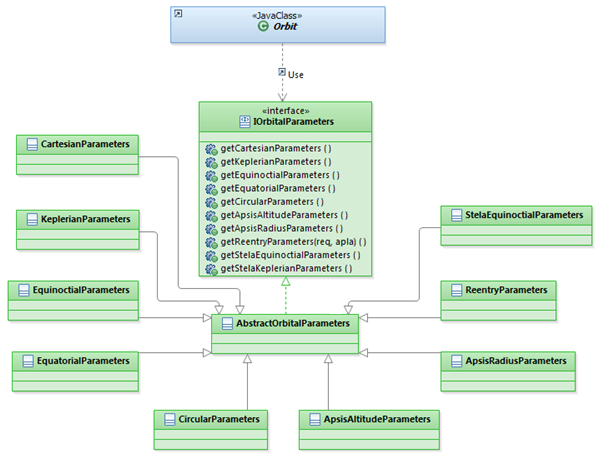User Manual 4.15 Orbital parameters
Introduction
Scope
The "Orbital parameters" package contains classes to represent the orbital state of a space object. Several types of parameters are available (cartesian, keplerian, equinoctial... with different position angle definitions : true, mean, eccentric). Orbital parameters do not define a date nor a frame. To fully define an orbit, including date and frame, please refer to [FDY_Orbits_Home Orbits].
Javadoc
The classes for orbital parameters description are available in the package fr.cnes.sirius.patrius.orbits.orbitalparameters.
| Library | Javadoc |
|---|---|
| Patrius | Package fr.cnes.sirius.patrius.orbits.orbitalparameters |
Links
None as of now.
Useful Documents
None as of now.
Package Overview
All different orbital parameters types extend the abstract class AbstractOrbitalParameters and implement the interface IOrbitalParameters (the following class package may not contain all classes extending AbstractOrbitalParameters class).
All conversions methods from one type to another are specifically handled by each type of orbital parameters, thus optimising conversions.
Features Description
Available parameters
The available parameters types are :
- Cartesian : X, Y, Z, Vx, Vy, Vz
- Keplerian : a, e, i, perigee argument, right ascension of ascending node, anomaly (in each position angle types)
- Equinoctial : a, ex, ey (eccentricity vector), hx, hy (inclination vector), longitude argument (in each position angle types)
- Alternate equinoctial : n (mean motion), ex, ey (eccentricity vector), hx, hy (inclination vector), longitude argument (in each position angle types but stored in mean)
- Stela Equinoctial : a, ex, ey (eccentricity vector), ix, iy (inclination vector), mean longitude argument
- Circular : a, ex, ey (eccentricity vector), i, right ascension of ascending node, latitude argument (in each position angle types)
- Apsis (using radius) : periapsis, apoapsis, i, perigee argument, right ascension of ascending node, anomaly (in each position angle types)
- Apsis (using altitude) : altitude of periapsis, altitude of apoapsis, i, perigee argument, right ascension of ascending node, anomaly (in each position angle types)
- Equatorial : a, e, longitude of the periapsis (ω + Ω), ix (first component of inclination vector), iy (second component of inclination vector), anomaly (in each position angle types)
- Reentry : altitude, latitude, longitude, velocity norm, slope of velocity, azimuth of velocity
Getting Started
Any orbital parameters can be defined using the chosen constructor. Here is an example using circular parameters and true anomaly:
final CircularParameters circularParameters = new CircularParameters(10000E3, 0.1, 0.2, 0.3, 0.4, 0.5, PositionAngle.TRUE, Constants.EGM96_EARTH_MU);
Then conversions to any orbital parameters type can directly be obtained using the conversion routines. Here is an example of conversion to equinoctial parameters:
final EquinoctialParameters equinoctialParameters = circularParameters .getEquinoctialParameters();
Contents
Interfaces
None as of now.
Classes
| Class | Summary | Javadoc |
|---|---|---|
| CartesianParameters | Cartesian parameters object. | ... |
| KeplerianParameters | Keplerian parameters object. | ... |
| CircularParameters | Circular parameters object. | ... |
| EquinoctialParameters | Equinoctial parameters object. | ... |
| AlternateEquinoctialParameters | Alternate Equinoctial parameters object. | ... |
| StelaEquinoctialParameters | Stela equinoctial parameters object. | ... |
| EquatorialParameters | Equatorial parameters object. | ... |
| ApsisRadiusParameters | Apsis parameters object (using radius). | ... |
| ApsisAltitudeParameters | Apsis parameters object (using altitude). | ... |
| ReentryParameters | Reentry parameters object. | ... |
